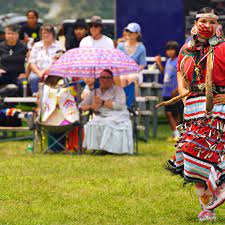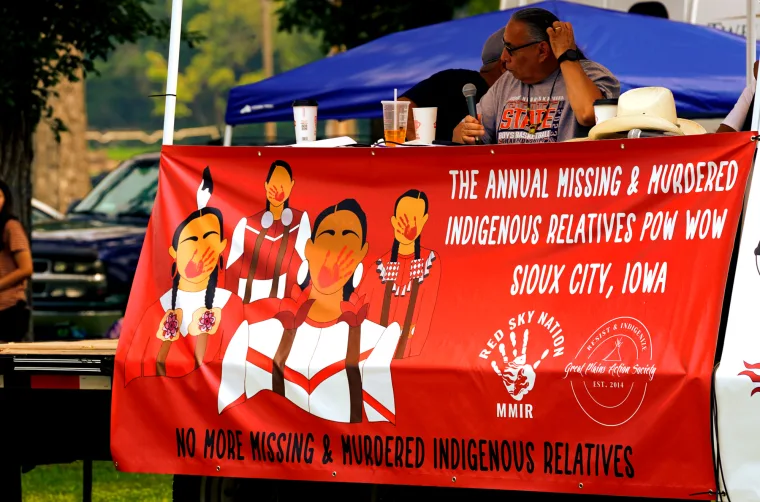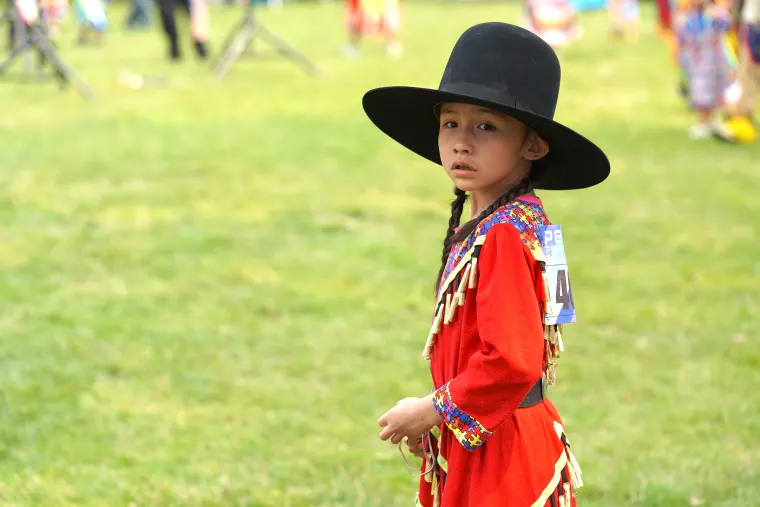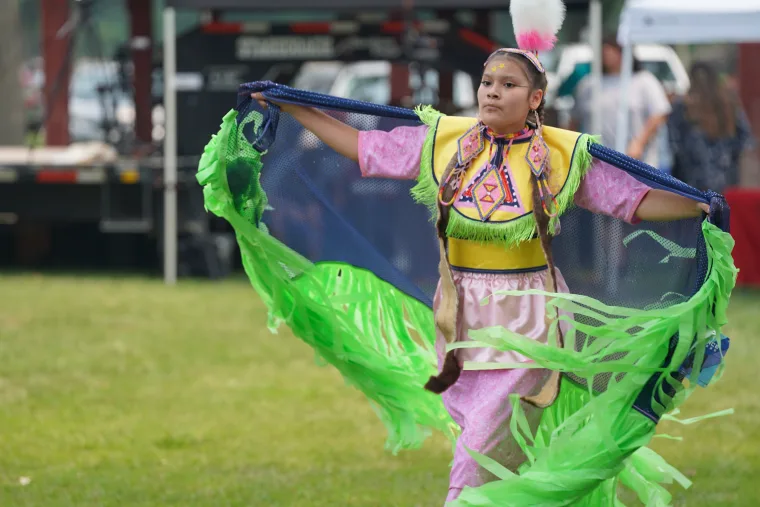News Based on facts, either observed and verified directly by the reporter, or reported and verified from knowledgeable sources.
Powwow spotlights missing and murdered Indigenous crisis
 Kaitlyn Miller, 14, Omaha Tribe, dances in a jingle dress at the Missing and Murdered Indigenous Relatives Pow Wow on Saturday, July 15, 2023 in Sioux City, Iowa. Miller was crowned princess at the powwow. (Kevin Abourezk, ICT)
Kaitlyn Miller, 14, Omaha Tribe, dances in a jingle dress at the Missing and Murdered Indigenous Relatives Pow Wow on Saturday, July 15, 2023 in Sioux City, Iowa. Miller was crowned princess at the powwow. (Kevin Abourezk, ICT)
Annual Missing and Murdered Indigenous Relatives Pow Wow in Iowa spreads awareness through song, dance and storytelling
Paulette Walker left her home in the 1980s, bound for Riverside, California with her husband.
When she got there, the 20-something-year-old Winnebago woman sent a postcard to her father. She was never heard from again.
Some time later, a police officer investigating a car accident in Riverside happened upon her body. She had been strangled. No one was ever held accountable for her death, and her family has never stopped looking for answers.
“We are in the process of exhuming her body and bringing her back,” said Trisha Rivers, Paulette’s niece.
Paulette’s story was one of several told this weekend during the second annual Missing and Murdered Indigenous Relatives Pow Wow held in Sioux City, Iowa. The event drew hundreds of singers, dancers, vendors and visitors to Riverside Park.

The powwow is a rarity in Indian Country, said Sikowis Nobiss, executive director for the Great Plains Action Society, which hosted the event in partnership with the family of another slain Native woman. Few powwows are focused entirely on missing and murdered Indigenous relatives, she said.
“This event right here is addressing (MMIR) through culture, tradition and community gathering, which is the Native way of life, and that’s the best way you can do it,” Nobiss said. “That’s how we heal. That’s how we empower ourselves, and that’s how we push back at what’s happening.”
The powwow, which was held July 14-16, featured several special events focused on individual Native women who lost their lives to violence, including a ribbon skirt contest dedicated to Ashlea Aldrich, a 29-year-old Omaha Native woman whose beaten body was found on her reservation in January 2020. Nobody was ever charged in her death.
The powwow also featured an MMIR princess dance contest that ended with event organizers crowning Kaitlyn Miller, a 14-year-old Omaha girl, as the powwow’s princess. Miller said she dances to honor her father, who passed away.
“It means a big deal to me, because I want to represent my tribe, my community and family,” said Miller, who danced with a red hand painted on her face to symbolize the silencing of Native women.
The event also featured relatives of murdered women speaking about their loved ones, and the Great Plains Action Society circulated a brochure detailing the deaths of several Indigenous women and men who had lost their lives to violence in the Sioux City area. They included:
- Terri McCauley, an 18-year-old Native woman who disappeared in 1983 and whose body was later found with a gunshot wound on her face. She had been left in a wooded area. No one was ever charged in her death.
- Kozee DeCorah, a 22-year-old Ho-Chunk woman who was murdered by her child’s father on the Winnebago reservation in May 2020. Her remains were found in a fire started by her boyfriend, who was later convicted of voluntary manslaughter and destruction of evidence and given 25 years in prison.
- Zachary Bear Heels, a 29-year-old Kiowa and Rosebud Lakota man who died in June 2017 after an encounter with Omaha police in which he was shocked 12 times by a stun gun and punched repeatedly in the head. Two officers were charged in his death, but one was acquitted by a jury and the other had his charges dropped by prosecutors.
In the United States, the third leading cause of death for Native women is murder, according to the Centers for Disease Control and Prevention. According to the National Institute of Justice, four out of five Native women experience violence in their lifetimes, and more than half of Native women have experienced sexual violence.

Native men also suffer high rates of violence. According to the National Institute of Justice, more than four in five Native men have experienced violence, and 28 percent of Indigenous men have experienced sexual violence.
Two-Spirit Native people also suffer from high rates of violence. According to the Minnesota Two-Spirit Society, 78 percent of Two-Spirit women had been physically assaulted, and 85 percent had been sexually assaulted.
The federal government has enacted several laws in recent years meant to address the MMIR epidemic, including reauthorizing the Violence Against Women Act in 2022, which included some protections for Native women, and the Not Invisible Act, which signed into law in 2022 and was designed to ensure law enforcement, tribal leaders and federal agencies cooperate to address the MMIR issue.
But much work remains, Nobiss said.
“The government has always done very little and is still doing very little to figure out what exactly is going on, to get us the statistics we need and to really clamp down on something that is so serious and violent and so horrific to the indigenous community,” she said.
She said she hopes the annual powwow will continue to serve as a tool to educate people about the missing and murdered Indigenous relatives epidemic and to galvanize Natives and non-Natives to work to stop it.
“It’s like really emotional, but you know it’s all for a good reason, and hopefully it’ll keep growing and maybe there’ll be more powwows like this across the country,” Nobiss said.

On Saturday at the powwow, Woodbury County Attorney James Loomis talked about his office’s efforts to investigate cold crimes. He said he needs cooperation from the Native community to find answers to those crimes.
“I want you to know that I have not forgotten certain things that have happened 30-plus years ago in Woodbury County, things that happened long before I had any desire to be a prosecutor,” he said. “But I want you to know that I am reviewing all of those things.”
Dateline:
SIOUX CITY, Iowa
